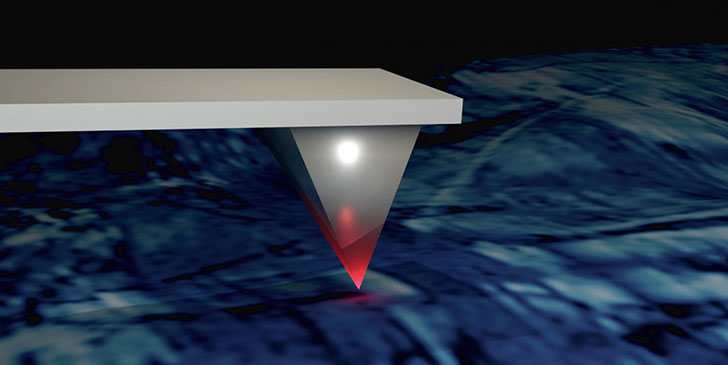
Schematic representation of the atomic force microscope interacting with the material surface. Image by Rama Vasudevan, ORNL.
Knowing where and how phase transitions occur is critical to developing materials for high-performance batteries, sensors, energy-harvesting devices, medical diagnostic equipment and other applications, but we lacked a means of both studying and mapping at the relevant length scales.
Researchers at the Georgia Institute of Technology and Oak Ridge National Laboratory (ORNL) have developed a new nondestructive technique for investigating these material changes by examining the acoustic response at the nanoscale. Information obtained from this technique - which uses electrically-conductive atomic force microscope (AFM) probes - could guide efforts to design materials with enhanced properties at small size scales.
The approach has been used in ferroelectric materials, but could also have applications in ferroelastics, solid protonic acids and materials known as relaxors. Sponsored by the National Science Foundation and the Department of Energy's Office of Science, the research was reported December 15, 2015 in the journal Advanced Functional Materials.
In ferroelectric materials such as PZT (lead zirconate titanate), phase transitions can occur at the boundaries between one crystal type and another, under external stimuli. Properties such as the piezoelectric and dielectric effects can be amplified at the boundaries, which are caused by the multi-element confused chemistry of the materials. Determining when these transitions occur can be done in bulk materials using various techniques, and at the smallest scales using an electron microscope.
The researchers realized they could detect these phase transitions using acoustic techniques in samples at size scales between the bulk and tens of atoms. Using band-excitation piezoresponse force microscopy (BE-PFM) techniques developed at ORNL, they analyzed the resulting changes in resonant frequencies to detect phase changes in sample sizes relevant to the material applications. To do that, they applied an electric field to the samples using an AFM tip that had been coated with platinum to make it conductive, and through generation and detection of a band of frequencies.
The changes the researchers detect acoustically are due to the elastic properties of the materials, so virtually any material with similar changes in elastic properties could be studied in this way. Bassiri-Gharb is interested in ferroelectrics such as PZT, but materials used in fuel cells, batteries, transducers and energy-harvesting devices could also be examined this way.
The researchers also modeled the relaxor-ferroelectric materials using thermodynamic methods, which supported the existence of a phase transition and the evolution of a complex domain pattern, in agreement with the experimental results.
Use of the AFM-based technique offers a number of attractive features. Laboratories already using AFM equipment can easily modify it to analyze these materials by adding electronic components and a conductive probe tip, Bassiri-Gharb noted. The AFM equipment can be operated under a range of temperature, electric field and other environmental conditions that are not easily implemented for electron microscope analysis, allowing scientists to study these materials under realistic operating conditions.
Though widely used, relaxor-ferroelectrics and PZT are still not well understood. In relaxor-ferroelectrics, for example, it's believed that there are pockets of material in phases that differ from the bulk, a distortion that may help confer the material's attractive properties. Using their technique, the researchers confirmed that the phase transitions can be extremely localized. They also learned that high responses of the materials occurred at those same locations.
Next steps would include varying the chemical composition of the material to see if those transitions - and enhanced properties - can be controlled. The researchers also plan to examine other materials.